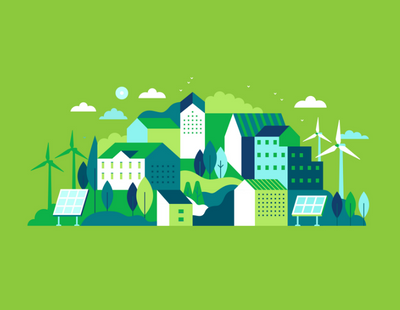New research reveals nearly half a million homes could be built across London on land that currently lies derelict amid a worsening housing crisis in the capital.
London’s brownfield space, defined as previously developed plots of land that are no longer in use, covers a vast expanse of 3,515 hectares – around 25 times the size of Hyde Park.
Our team here residential block and facilities management company SBA Property Management analysed local authority data and found that the city's brownfield space could accommodate a minimum of 414,273 new homes if put into use.
At present, however, only approximately 56% of brownfield sites have full planning permission for work to proceed, meaning there are thousands of sites standing unused without any plans for redevelopment. The news comes at a time of acute housing shortages across the capital, with many Londoners pushed into insecure or unaffordable accommodation.
Slowed progress
In 2021, City Hall set targets of delivering 52,000 new homes a year, though so far it has failed to reach its annual goal on any occasion. Brownfield space could accommodate most of these new homes, however strict planning laws and high development costs have slowed progress.
London’s vast reserves of brownfield space hold the key to alleviating the city’s housing shortages and catalysing local economic growth, while also reducing pressure to build on precious Green Belt land.
At present, however, thousands of brownfield sites lie empty across London, with development made difficult by complex planning regulations. For private owners, speaking to a property expert can help clarify key aspects of compliance and accelerate the process of bringing derelict land back into productive use.
Of all London boroughs, Southwark holds the greatest potential for brownfield development, containing the largest amount of brownfield space both in terms of area and housebuilding capacity.
Local authority data shows that the borough’s derelict plots of land could accommodate at least 54,550 new homes. However, just 37% of brownfield sites have full planning permission for development – well below the average for London as a whole.
Other boroughs with significant brownfield capacity include Brent, Wandsworth, Waltham Forest and Haringey, all of which could house at least 25,000 new homes if derelict land was put into use.
The incentives for developing brownfield space are strong as nearby amenities and transport infrastructure are often already in place, reducing the need for further development in surrounding areas. Bringing derelict land back into use can also provide community benefits by creating jobs, improving the environment and raising property values.
Immense potential
The challenge for private owners and public authorities is to overcome obstacles like site contamination and poor ground conditions that often make brownfield development costly. In recent years, the government has taken steps to reduce these barriers by delivering £180m in funding to councils as part of the Brownfield Land Release Fund.
Planning rules for brownfield development have also been eased, with local authorities instructed to be more flexible when reviewing brownfield planning applications, particularly in areas that are falling behind housebuilding targets.
The changes have been welcomed by the construction industry and should resolve some of the issues that have prevented brownfield development historically.
It is hoped that the relaxed planning framework can usher in a new era of urban regeneration, maximising the immense potential of London’s brownfield space.
Research
|
Borough
|
Number of brownfield plots available
|
Of which have full planning permission
|
Hectares
|
Minimum new dwellings from available brownfield space
|
|
Camden
|
125
|
94
|
137.1
|
12,580
|
|
City of London
|
0
|
0
|
0
|
0
|
|
Hackney
|
37
|
15
|
52.4
|
4,194
|
|
Hammersmith and Fulham
|
29
|
27
|
48.7
|
6,348
|
|
Haringey
|
278
|
184
|
178.6
|
25,667
|
|
Islington
|
133
|
102
|
83.9
|
9,033
|
|
Kensington and Chelsea
|
31
|
16
|
34.4
|
6,871
|
|
Lambeth
|
134
|
116
|
51.7
|
8,025
|
|
Lewisham
|
265
|
163
|
121.1
|
18,398
|
|
Newham
|
52
|
31
|
6.3
|
922
|
|
Southwark
|
788
|
288
|
383.3
|
54,550
|
|
Tower Hamlets
|
26
|
7
|
96.0
|
130
|
|
Wandsworth
|
215
|
156
|
211.3
|
28,353
|
|
Westminster
|
169
|
145
|
63.9
|
9,241
|
|
Barking and Dagenham
|
63
|
39
|
277.4
|
23,488
|
|
Barnet
|
79
|
66
|
151.6
|
21,996
|
|
Bexley
|
137
|
88
|
84.2
|
8,621
|
|
Brent
|
254
|
163
|
231.9
|
29,086
|
|
Bromley
|
67
|
44
|
36.7
|
3,382
|
|
Croydon
|
359
|
243
|
111.1
|
10,587
|
|
Ealing
|
70
|
23
|
111.7
|
7,026
|
|
Enfield
|
27
|
21
|
49.8
|
2,170
|
|
Greenwich
|
123
|
104
|
141.8
|
23,884
|
|
Harrow
|
102
|
48
|
102.5
|
7,634
|
|
Havering
|
95
|
32
|
85.8
|
13,161
|
|
Hillingdon
|
148
|
80
|
88.8
|
9,268
|
|
Hounslow
|
179
|
100
|
67.7
|
10,875
|
|
Kingston upon Thames
|
47
|
20
|
63.8
|
6,538
|
|
Merton
|
107
|
67
|
63.6
|
7,599
|
|
Redbridge
|
144
|
35
|
94.1
|
11,551
|
|
Richmond upon Thames
|
51
|
26
|
79.8
|
2,042
|
|
Sutton
|
95
|
31
|
33.1
|
2,772
|
|
Waltham Forest
|
242
|
50
|
170.6
|
28,281
|
|
London
|
4,671
|
2,624
|
3,515
|
414,273
|







.jpg)





.png)


.png)



Join the conversation
Be the first to comment (please use the comment box below)
Please login to comment